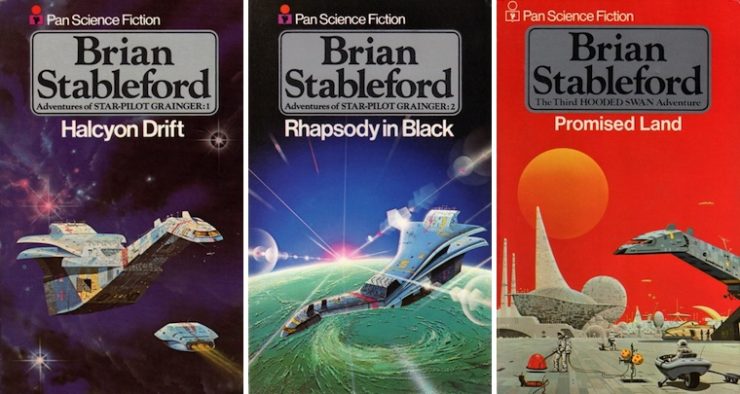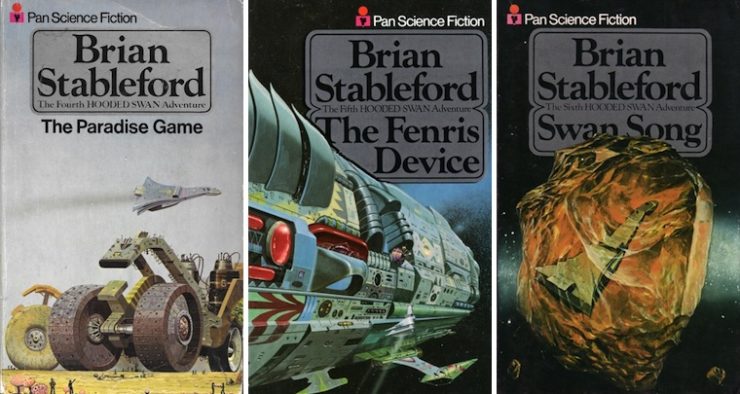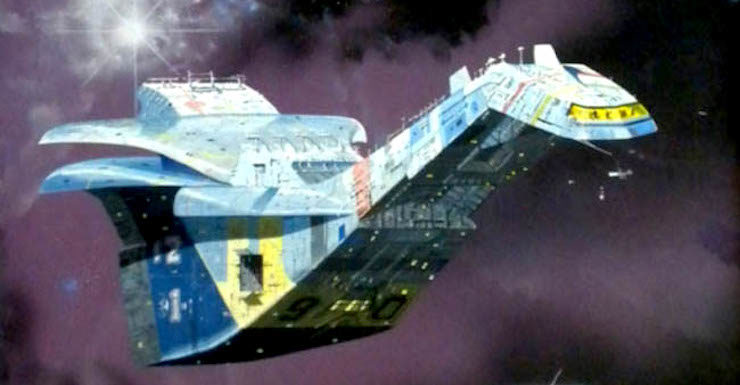I don’t remember how I first found Brian Stableford’s “Hooded Swan” series, but it was back in the days before the Internet was everywhere, when people still discovered books the old-fashioned way, on the shelves of a bookshop. It was probably the spectacular Angus McKie cover art of the Pan editions that caught my eye, selling me on the book and Stableford’s universe before I’d even read the first line. Once I started reading, though, I was hooked. Many years later, the series still holds a special place in my heart.
One of the most impressive things is how much Stableford managed to cram into six slim volumes. Each book is a self-contained story in barely more than novella length. The action moves at a brisk pace, but Stableford still finds room to describe the specifics of his alien ecosystems or the politics of the larger universe. It’s all done so deftly and economically and with such apparent confidence that it comes as a shock to realize that the “Hooded Swan” novels were among his earliest works, the start of a long and prolific career.
So what are they about? Briefly summarized, the series covers the adventures of a man named Grainger, who is recruited—press-ganged might be a better description—as a test pilot for an experimental starship, the ‘Hooded Swan’ of the title. (‘hooded swan’ is another name for the dodo, a detail that Grainger doesn’t fail to remark on).
They’re also about a time of transition. The corporations—huge commercial empires—are emerging as the dominant powers in the galaxy, flexing their muscles and jockeying for position against each other and the older galactic powers. Grainger’s job gives him a privileged position from which to observe the struggle, but it’s still a worm’s-eye view of history. In his own words, he’s no more than a pawn in the game.

When Stableford does his world-building, he’s faithful to Grainger’s restricted perspective. He doesn’t explain the grand strategic picture; he tells us what Grainger knows. In the same way, he doesn’t waste time on technological exposition. There are multiple types of faster-than-light starship—ramrods, p-shifters, dimension hoppers—but we never get an explanation of how each one works. Grainger doesn’t think about these things any more than you or I would interrupt our own internal monologue to muse on the workings of the internal combustion engine. What Grainger tells us are the things that are novel or relevant to him. Exploring a wrecked starship, Grainger observes “… her engine had gone exactly like the Hymnia’s. It’s the way dimension hoppers nearly always go.” We still don’t know how dimension hoppers work, but now we know a fact about them, and knowing it makes them seem more real.
There’s a lesson here for aspiring writers. Not only do you not need to explain everything, but sometimes what you leave out is as important as what you put in. When required, Stableford gives us all the detail we need—he’s a biologist and sociologist by training, and several of the plots hinge on features of alien ecosystems or societies. But he is careful never to give us more than we need. The function of world-building isn’t to explain how the world works; it’s to convince the reader that it does. Seeing everything through Grainger’s eyes, focusing only on what he pays attention to, we accept the universe as a coherent reality, even if we don’t know all the details.
Worldbuilding sets the stage, but a story needs an emotional core too. The key here is Grainger himself, and Stableford pulls it off with another clever trick.
Grainger is, in some ways, a familiar SFF trope: the skilled technocrat in indentured servitude to an employer he didn’t choose and doesn’t trust. You could see him as a forerunner of Takeshi Kovacs from “Altered Carbon” or Case from “Neuromancer”. In other ways, however, he’s a quite atypical SF hero. For one thing, he’s a confirmed pacifist—not a starry-eyed idealist preaching universal love and brotherhood, but a man who hates violence because he’s seen too much. Grainger doesn’t leave a trail of bodies; he solves problems with his brain, not his fists or a laser gun. When the bodies pile up anyway, he regrets every one.
In the same way, “Hooded Swan” doesn’t have any obvious villains. Even Grainger’s natural enemies, the employees of the corporations, are mostly just working slobs trying to make a wage. The ‘bad guys’ of the stories are abstractions: corporate greed, hubris, fanaticism. The major antagonists are biology and physics.
Grainger himself is profoundly alienated. He is—or professes to be—a cynical nihilist, emotionally cut off from other people. He’s also alienated in the Marxist sense, deprived of control over his life and work, a hired hand, pilot but not captain of the ship he flies. The corporate future offers him little more than a role as a cog in the machinery of some vast enterprise.
He’s also alienated in a third, more literal sense: he has an alien living in his brain. The alien, which Grainger calls ‘the wind’, is a body-hopping symbiote that manifests as a voice in his mind. Grainger loathes this uninvited passenger, but the books wouldn’t be the same without the dialogues between the wind and its unwilling host.

“Hooded Swan” is told in the first person, something that probably makes Grainger more sympathetic to us than he might be to his peers. He’s entertainingly grouchy; being inside his head is a fun ride. Stableford lets us suspect that actually being around him, especially in the cramped confines of a starship, might be less amusing. In person, he might be at best annoying, at worst deeply disagreeable.
Or so he says. But this is where Stableford pulls his neat trick. It soon becomes clear that while Grainger can be trusted to recount events accurately, he’s a deeply unreliable narrator when it comes to his own motivations. He may affect not to care for anything or anyone but his actions say otherwise. And, interestingly, the wind also says otherwise. The wind is a mimic; its own ‘personality’ is an imitation of Grainger’s. So when the alien seems more human than the man, we have to wonder if we’re not seeing another side of Grainger, one that does him more credit than he’s willing to give himself.
“Hooded Swan” is a portrait of a complex man. The narrative device of the wind allows Stableford to present Grainger’s character from multiple angles, revealing him as a richer and more rewarding character than just the wisecracking cynic he seems to be. And that makes possible the unexpectedly poignant conclusion of the series, with its suggestion that not only has Grainger grown but that he might yet grow more.
Readers of my novella The Warrior Within may detect echoes of “Hooded Swan” in the story, echoes that I only noticed myself after I’d finished writing. Yet if the superficial similarities were unplanned, I was quite consciously trying to do what Stableford does: to tell a full and satisfying story in a very compact format. If I’ve succeeded even half as well as he did, I’ll be well pleased.
 Angus McIntyre was born in London and has lived in Edinburgh, Milan, Brussels and Paris before eventually finding his way to New York, where he now lives and works. A graduate of the 2013 Clarion Writer’s Workshop, his short fiction has been published in numerous anthologies and on BoingBoing. His background in computational and evolutionary linguistics and in artificial intelligence has given him a healthy respect for positive feedback loops and a certain curiosity about what it might be like to live in a universe filled with intelligent machines. His hobbies include travel and photography. His first published book is The Warrior Within.
Angus McIntyre was born in London and has lived in Edinburgh, Milan, Brussels and Paris before eventually finding his way to New York, where he now lives and works. A graduate of the 2013 Clarion Writer’s Workshop, his short fiction has been published in numerous anthologies and on BoingBoing. His background in computational and evolutionary linguistics and in artificial intelligence has given him a healthy respect for positive feedback loops and a certain curiosity about what it might be like to live in a universe filled with intelligent machines. His hobbies include travel and photography. His first published book is The Warrior Within.











The Hooded Swan series is one of my favorites, and specifically it’s the one favorite that almost nobody I mention it to, even in SF-reading circles, knows about. So I just love that it got a great write-up here.
I think I have Halcyon Drift (with the Angus McKie cover shown) but I don’t recall much about it and I haven’t read any other Stableford. On the other hand, weird old British space opera can be my kind of thing and after reading this I’m tempted to give them another go.
OK, I’ve never read these books (didn’t even know they existed, in fact) but I vividly recognize at least five of those covers (all but Rhapsody in Black), which were repurposed for various Terran Trade Authority books back in the day. Might have to seek out the books, just on general principles.
EDIT: And all six are available as eBooks on the US Amazon site, although with much less striking covers.
The function of world-building isn’t to explain how the world works; it’s to convince the reader that it does.
Yes. Very well-put.
The days when book covers were something made to stand out and be distinctive. These days they are just perfunctory afterthoughts, usually either some generic blocky spaceship or a fauxtorealistic picture of a woman, half turned away from the reader and scowly-pouting, set against a murky background.
Get better book covers, everyone.
I remember buying them in the 1970s: the US Editions came out from DAW and had gorgeous Frank Kelly Freas covers.
Never heard of- must buy!
That Halcyon Drift cover reminds me so strongly of artwork for Jodorowsky’s Dune, I was sure it was the same artist. But nope, not Angus McKie, that was Chris Foss. It suggests how artwork really is a product of its time, creative though the artists may be.
@3
Ha, yeah, I went straight to the TTA books as well. There was a whole bunch of artists who had similar design ethos at that time, Chris Foss is probably the bestknown one.
I’m now quite curious to track down the originals – Stableford is a name I knew growing up by ever had the opportunity to read.
Such a great series, thanks for introducing more people to it!
I just got the ebook edition of Halcyon Drift as a result of this post, and I’m enjoying it greatly.
Great to see the Hooded Swan books getting some love. I reread them on a regular basis – I have both the original Pan editions and on ebook – and I also come to them from the TTA books!
Stableford has written better books, but nothing as entertaining (I used to have a pretty much complete collection of his books, but I’ve fallen behind as he’s migrated mainly to small presses.)
You might also want to check out Stableford’s Daedalus Mission books. It’s another six book series about a team of biologists (mostly) who are making contact with human-colonized worlds that have been out of touch since they were originally settled (due to Earth going through a two hundred year rough patch). None of the characters are as compelling as Granger (there’s not a lot to distinguish them from each other), but the world-building is generally quite good.
Catching this just as it falls off my conversations page to say I have bought the Wildside ebook series bundle.